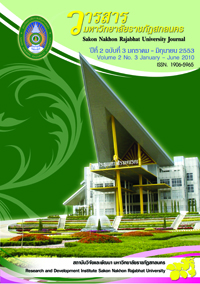ผลของการใช้สมุนไพรชนิดต่างๆ ร่วมกับน้ำสกัดชีวภาพ ในการยับยั้งการเกิดโรคในลูกอ๊อดกบ
Abstract
บทคัดย่อ
งานวิจัยครั้งนี้ เป็นการวิจัยเพื่อศึกษาองค์ความรู้ในการเพาะเลี้ยงลูกอ๊อดกบ สาเหตุของการเกิดโรค และศึกษาผลของการใช้สมุนไพรชนิดต่าง ๆ ได้แก่ ใบมะระขี้นก ใบฝรั่ง ใบกระเพรา และใบมะยม ร่วมกับ น้ำสกัดชีวภาพ ในการยับยั้งการเกิดโรคในลูกอ๊อดกบ จากการศึกษาวิจัยทั้งหมด สรุปได้ดังนี้
การศึกษาองค์ความรู้ในการเพาะเลี้ยงลูกอ๊อดกบ ในจังหวัดสกลนคร โดยทำการสัมภาษณ์แบบ เจาะลึก (In-depth Interview) และการสังเกตแบบมีส่วนร่วมในชุมชนบ้านน้อยจอมศรี และบ้านดอนตาลโง๊ะ อ.เมือง จ.สกลนคร พบว่าเกษตรกรส่วนใหญ่จะทำการเพาะเลี้ยงลูกอ๊อดกบเป็นอาชีพหลัก บางครัวเรือนทำ อาชีพนี้มานานถึง 10 ปี ฤดูกาลในการเลี้ยงจะเริ่มในช่วงเดือนมีนาคมของทุกปี โดยคัดพ่อแม่พันธุ์อัตราส่วน เพศผู้ต่อเพศเมียเท่ากับ 1:1 จำนวน 20 คู่มาเพาะในกระชังขนาด 3x3 ตารางเมตร ระดับน้ำ 10 เซนติเมตร โดย ปล่อยพ่อแม่พันธุ์ในช่วงเวลา 18.00 น. เมื่อเวลา 06.00 น.จึงนำพ่อแม่พันธุ์ออกไปพักไว้ในบ่อดินส่วนไข่กบที่ ได้รับการผสมแล้วจะเจริญเติบโตเป็นลูกอ๊อด ทำการอนุบาลด้วยอาหารเม็ดขนาดเล็กจนลูกอ๊อดอายุ 21 วัน หลังจากนั้นลูกอ๊อดจะเจริญเติบโตเป็นลูกกบ บางตัวจะเกาะตามขอบกระชังจึงทำการคัดเลือกไว้เลี้ยงในบ่อดิน เพื่อเป็นพ่อแม่พันธุ์ต่อไป ไม่พบปัญหาด้านการตลาด เนื่องจากจะมีลูกค้าทั้งในจังหวัดและต่างจังหวัดมารับซื้อ ถึงหน้าฟาร์มตั้งแต่ลูกอ๊อดมีอายุ 13-21 วัน ราคากิโลกรัมละ 200-250 บาท
การหาสาเหตุของการเกิดโรคในลูกอ๊อดกบโดยทำการตรวจในห้องปฏิบัติการเริ่มตั้งแต่การตรวจ วิเคราะห์น้ำจากบ่อเลี้ยงพบว่า มีปริมาณของแอมโมเนียไนโตรเจน (NH3-N)อยู่ในระดับที่ไม่ปลอดภัยต่อ ลูกอ๊อด คือมีค่าเฉลี่ยเท่ากับ 2.8 มิลลิกรัม/ลิตร ซึ่งสูงเกินกว่าที่สัตว์น้ำจะทนได้ ซึ่งระดับที่สัตว์น้ำทนได้คือไม่ เกิน 0.02 มิลลิกรัม/ลิตร (สถาบันประมงน้ำจืดแห่งชาติ, 2530) นอกจากนี้การตรวจตัวอย่างสัตว์น้ำที่มีอาการ ป่วยโดยเก็บจากพ่อแม่พันธุ์และจากลูกอ๊อดกบ ผลการตรวจภายนอกพบอาการผิดปกติของสัตว์น้ำ คือ มีแผลสี แดงบริเวณขา แผลหลุมลึกที่ผิวหนัง ท้องบวม การตรวจภายในพบว่าในช่องท้องกบมีของเหลวสะสมและเมื่อ ตรวจวิเคราะห์โดยนำมาเลี้ยงบนอาหารเลี้ยงเชื้อ TSA (Tryptic Soy Agar) และย้อมสีแกรมพบว่าเป็นกลุ่มของ แบคทีเรียแกรมลบ
การทดสอบเชื้อกับสมุนไพรชนิดต่าง ๆ ได้แก่ ใบมะระขี้นก ใบฝรั่ง ใบกระเพรา และใบมะยมใน ห้องปฏิบัติการ พบว่าใบฝรั่งทำให้แบคทีเรียที่ทดสอบไม่สามารถเจริญเติบโตบนอาหารเลี้ยงเชื้อได้ เมื่อทำการ ทดลองเลี้ยงในฟาร์มโดยปล่อยลูกอ๊อดกบอายุ 3 วัน ในบ่อซีเมนต์กลม อัตราความหนาแน่น 100 ตัว/ตารางเมตร ให้อาหารผสมสมุนไพรชนิดต่าง ๆ ร่วมกับน้ำสกัดชีวภาพ โดยใช้น้ำสกัดชีวภาพสเปรย์ทั่วบ่อทุกสัปดาห์ ผล ปรากฏว่า บ่อที่เลี้ยงโดยใช้ใบฝรั่งร่วมกับน้ำสกัดชีวภาพ มีอัตรารอดและอัตราการเจริญเติบโตดีที่สุด และไม่ พบว่ามีแผลหรืออาการผิดปกติของลูกอ๊อดกบ
Abstract
The purpose of this research were to study the body of knowledge on frog breeding and causes of using different kinds of herbs such as Momordica charantia, Psidium guajava, Ocimum sanctum and Phyllanthus acidus with bio-extract on preventing diseases in tadpoles. The results of study were as follows.
From studying the body of knowledge on frog breeding in Sakon Nakhon province through in-depth interview and participatory observation with frog breeders in Ban Noijomsri and Ban Donta-ngo it was found that most farmers breed frogs as their main occupation. Some households have had this occupation for ten years. The breeding season begins around March every year. Twenty couples of breeding stocks are bred in a 3x3 meter breeding cage in 10-centimeter-deep water. The breeding stocks are kept in the breeding cage for mating from 6.00 p.m. to 6.00 a.m. and then they are allowed to lay eggs in a pond. The fertilized eggs will hatch into tadpoles. These young are fed with fine-grained feed until they are 21 days old. After that these tadpoles will develop to young frogs. Some of these will cling to the sides of the cage and will be selected to be new breeding stocks. There is no problem in marketing of tadpoles because frog raisers from both Sakon Nakhon and other provinces will come to the farm to buy tadpoles. The price for 13-21 day old tadpoles is 200-250 baht per kilogram.
From trying to identify the causes of diseases in tadpoles through laboratory examination beginning with water analysis of the water in the pond it was found that the level of NH3-N was 2.8 mg/l, which was much higher than the optimum level of 0.02 mg/l. Therefore, it was not suitable for frog breeding. (Inland Fisheries Institute, 1987). Moreover, the diagnosis of infected tadpoles and frogs showed that, from external examination, there were ulcers on the leg and the skin of the frog, and there was also edema. From internal examination it was found that the frog had an accumulation of liquid in the abdomen. When the pathogens from the kidney, the spleen and the liver analyzed by culturing them on TSA media, they were found to be gram negative bacteria.
From laboratory tests of using the leaves of Momordica charantia, Psidium guajava, Ocimum sanctum and Phyllanthus acidus it was found that guava leaves could stop the growth of bacteria on TSA media. And from the experiment in raising 3-day-old tadpoles in cement ring tanks with 100 tadpoles per square meter density in which in each cement ring tank the tadpoles were fed with the feed mixed with a different kind of herb and bio-extract was sprayed all over the tank, it was found that the tadpoles fed with the feed mixed with guava leaves and sprayed with bio-extract had the highest survival rate and the highest grown rate. Ulcers and unusual condition of the tadpoles were not found.








